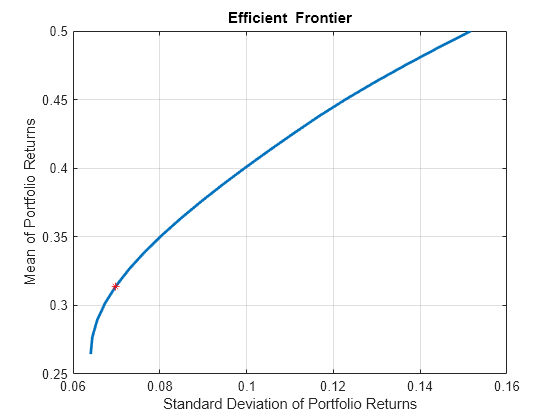estimateMaxSharpeRatio
估计有效投资组合以最大化 Portfolio 对象的夏普比率
语法
说明
示例
估计使夏普比率最大化的有效投资组合。estimateMaxSharpeRatio 函数可使有效边界上的投资组合中的夏普比率最大化。此示例使用默认的 'direct' 方法估计最大夏普比率。有关 'direct 方法的详细信息,请参阅算法。
p = Portfolio('AssetMean',[0.3, 0.1, 0.5], 'AssetCovar',... [0.01, -0.010, 0.004; -0.010, 0.040, -0.002; 0.004, -0.002, 0.023]); p = setDefaultConstraints(p); plotFrontier(p, 20); weights = estimateMaxSharpeRatio(p); [risk, ret] = estimatePortMoments(p, weights); hold on plot(risk,ret,'*r');

估计使夏普比率最大化的有效投资组合。estimateMaxSharpeRatio 函数可使有效边界上的投资组合中的夏普比率最大化。此示例对未指定跟踪误差且仅使用线性约束的 Portfolio 对象 (p) 使用 'direct' 方法。setSolver 函数用于控制 SolverType 和 SolverOptions。在本例中,SolverType 为 quadprog。有关 'direct' 方法的详细信息,请参阅算法。
p = Portfolio('AssetMean',[0.3, 0.1, 0.5], 'AssetCovar',... [0.01, -0.010, 0.004; -0.010, 0.040, -0.002; 0.004, -0.002, 0.023]); p = setDefaultConstraints(p); plotFrontier(p, 20); p = setSolver(p,'quadprog','Display','off','ConstraintTolerance',1.0e-8,'OptimalityTolerance',1.0e-8,'StepTolerance',1.0e-8,'MaxIterations',10000); weights = estimateMaxSharpeRatio(p); [risk, ret] = estimatePortMoments(p, weights); hold on plot(risk,ret,'*r');

估计使夏普比率最大化的有效投资组合。estimateMaxSharpeRatio 函数可使有效边界上的投资组合中的夏普比率最大化。此示例对指定了跟踪误差且使用非线性约束的 Portfolio 对象 (p) 使用 'direct' 方法。setSolver 函数用于控制 SolverType 和 SolverOptions。在本例中,fmincon 为 SolverType。
p = Portfolio('AssetMean',[0.3, 0.1, 0.5], 'AssetCovar',... [0.01, -0.010, 0.004; -0.010, 0.040, -0.002; 0.004, -0.002, 0.023],'lb', 0,'budget', 1); plotFrontier(p, 20); p = setSolver(p, 'fmincon', 'Display', 'off', 'Algorithm', 'sqp', ... 'SpecifyObjectiveGradient', true, 'SpecifyConstraintGradient', true, ... 'ConstraintTolerance', 1.0e-8, 'OptimalityTolerance', 1.0e-8, 'StepTolerance', 1.0e-8); weights = estimateMaxSharpeRatio(p); te = 0.08; p = setTrackingError(p,te,weights); [risk, ret] = estimatePortMoments(p,weights); hold on plot(risk,ret,'*r');
![]()
estimateMaxSharpeRatio 函数可使有效边界上的投资组合中的夏普比率最大化。在具有无风险资产的投资组合的情况下,有多个有效的投资组合可以最大化资产线的夏普比率。鉴于 'direct' 和 'iterative' 方法自身的性质,上述每种方法的投资组合权重 (pwgts) 输出可能会有所不同,但夏普比率是相同的。此示例演示了 pwgts 不同而夏普比率相同的情形。
load BlueChipStockMoments mret = MarketMean; mrsk = sqrt(MarketVar); cret = CashMean; crsk = sqrt(CashVar); p = Portfolio('AssetList', AssetList, 'RiskFreeRate', CashMean); p = setAssetMoments(p, AssetMean, AssetCovar); p = setInitPort(p, 1/p.NumAssets); [ersk, eret] = estimatePortMoments(p, p.InitPort); p = setDefaultConstraints(p); pwgt = estimateFrontier(p, 20); [prsk, pret] = estimatePortMoments(p, pwgt); pwgtshpr_fully = estimateMaxSharpeRatio(p,'Method','direct'); [riskshpr_fully, retshpr_fully] = estimatePortMoments(p,pwgtshpr_fully); q = setBudget(p, 0, 1); qwgt = estimateFrontier(q, 20); [qrsk, qret] = estimatePortMoments(q, qwgt);
绘制有效边界及其切线(现金比例为 0 到 1)。
pwgtshpr_direct = estimateMaxSharpeRatio(q,'Method','direct'); pwgtshpr_iter = estimateMaxSharpeRatio(q,'Method','iterative'); % Default for 'TolX' is 1e-8 [riskshpr_diret, retshpr_diret] = estimatePortMoments(q,pwgtshpr_direct); [riskshpr_iter, retshpr_iter] = estimatePortMoments(q,pwgtshpr_iter); clf; portfolioexamples_plot('Efficient Frontier with Capital Allocation Line', ... {'line', prsk, pret, {'EF'}, '-r', 2}, ... {'line', qrsk, qret, {'EF with riskfree'}, '-b', 1}, ... {'scatter', [mrsk, crsk, ersk, riskshpr_fully, riskshpr_diret, riskshpr_iter], ... [mret, cret, eret, retshpr_fully , retshpr_diret, retshpr_iter], {'Market', 'Cash', 'Equal','Sharpe fully invest', 'Sharpe diret','Sharpe iter'}}, ... {'scatter', sqrt(diag(p.AssetCovar)), p.AssetMean, p.AssetList, '.r'});

当投资组合中没有无风险资产时,换句话说,当投资组合满仓时,有效边界为曲线,对应于上图中的红线。因此,存在一个使夏普比率最大化的唯一(风险, 收益)点,'iterative' 和 'direct' 方法都可以找到该点。如果允许投资组合投资无风险资产,则红色有效边界线的一部分将被资产配置线代替,从而得到具有无风险投资的投资组合的有效边界(蓝线)。直的蓝线上的所有(风险, 收益)点都具有相同的夏普比率。此外,'iterative' 和 'direct' 方法很可能以不同的点结束,因此存在不同的投资组合分配。
在使用 'iterative' 方法时,您可以使用可选的 'TolX' 名称-值参量。TolX 是与有效边界可能的收益水平相关的终止容差。如果选择的 TolX 值与收益范围相比较大,则解的准确性较差。TolX 应该是一个小于 0.01*(maxReturn - minReturn) 的数值。
maxReturn = max(qret); % Max return portfolio minReturn = min(qret); % Min return portfolio display(0.01*(maxReturn-minReturn))
1.5193e-04
增大终止容差的目的是加快 'iterative' 算法的收敛速度。但是,如前所述,解的准确性将降低。您可以在下表中看到这一点。
pwgtshpr_iter_largerTol = estimateMaxSharpeRatio(q, 'Method', 'iterative',... 'TolX', 1e-4); display(table(pwgtshpr_iter, pwgtshpr_iter_largerTol,... 'VariableNames', {'Default TolX = 1e-8','TolX = 1e-4'}))
30×2 table
Default TolX = 1e-8 TolX = 1e-4
___________________ ___________
0 0
0 0
0 0
0 0
0 0
0 0
0 0
0 0
0 0
0 0
0 0
0 0
0 0
0 0
0.015523 0.015523
0.052472 0.052473
0 0
0 0
0 0
0.090335 0.090335
0.081562 0.081562
0 0
0.026094 0.026094
0 0
0.043466 0.043466
0 0
0.034997 0.034998
0 0
0.1285 0.1285
0.10979 0.10979
在上表中,权重的值与使用默认容差获得的权重相比略有不同,这符合预期。
为三项资产创建一个 Portfolio 对象。
AssetMean = [ 0.0101110; 0.0043532; 0.0137058 ];
AssetCovar = [ 0.00324625 0.00022983 0.00420395;
0.00022983 0.00049937 0.00019247;
0.00420395 0.00019247 0.00764097 ];
p = Portfolio('AssetMean', AssetMean, 'AssetCovar', AssetCovar);
p = setDefaultConstraints(p); 使用 setBounds 为 i = 1,...NumAssets 的所有资产设置半连续约束,使 xi = 0 或 0.02 <= xi <= 0.5。
p = setBounds(p, 0.02, 0.5,'BoundType', 'Conditional', 'NumAssets', 3);
当使用 Portfolio 对象时,setMinMaxNumAssets 函数支持您为纯多头投资组合设置基数约束。这为 Portfolio 对象设置了基数约束,其中满足非零半连续约束的已分配资产总数介于 MinNumAssets 和 MaxNumAssets 之间。通过设置 MinNumAssets = MaxNumAssets = 2,仅对投资组合的三项资产中的两项进行了投资。
p = setMinMaxNumAssets(p, 2, 2);
使用 estimateMaxSharpeRatio 估计有效投资组合以最大化夏普比率。
weights = estimateMaxSharpeRatio(p,'Method','iterative')
weights = 3×1
0
0.5000
0.5000
estimateMaxSharpeRatio 函数使用 MINLP 求解器来求解此问题。使用 setSolverMINLP 函数来配置 SolverType 和选项。
p.solverOptionsMINLP
ans = struct with fields:
MaxIterations: 1000
AbsoluteGapTolerance: 1.0000e-07
RelativeGapTolerance: 1.0000e-05
NonlinearScalingFactor: 1000
ObjectiveScalingFactor: 1000
Display: 'off'
CutGeneration: 'basic'
MaxIterationsInactiveCut: 30
ActiveCutTolerance: 1.0000e-07
IntMainSolverOptions: [1×1 optim.options.Intlinprog]
NumIterationsEarlyIntegerConvergence: 30
ExtendedFormulation: 0
NumInnerCuts: 10
NumInitialOuterCuts: 10
输入参数
名称-值参数
将可选参量对组指定为 Name1=Value1,...,NameN=ValueN,其中 Name 是参量名称,Value 是对应的值。名称-值参量必须出现在其他参量之后,但对各个参量对组的顺序没有要求。
在 R2021a 之前,请使用逗号分隔每个名称和值,并将 Name 用引号引起来。
示例: [pwgt,pbuy,psell] = estimateMaxSharpeRatio(p,'Method’,'iterative')
估计夏普比率的方法,指定为以逗号分隔的对组,其中包含 'Method' 和具有下列值之一的字符向量:
'direct'- 将夏普比率函数转换为二次函数,直接求解一个优化问题,而不是以迭代方式探索有效边界。'direct'选项使用求解器quadprog(对于具有线性约束的问题)或fmincon(对于具有非线性约束的问题)。有关使用'direct'选项的示例,请参阅 将求解器选项与 'direct' 方法结合使用,估计可使 Portfolio 对象的夏普比率最大化的有效投资组合 和 将 'direct' 方法与求解器选项结合使用,估计可使具有跟踪误差的 Portfolio 对象的夏普比率最大化的有效投资组合。'iterative'- 使用fminbnd进行一维优化,它通过迭代方式探查有效边界来找到使夏普比率最大化的投资组合。
注意
如果您在 estimateMaxSharpeRatio 中使用具有半连续和基数约束(由 setBounds 和 setMinMaxNumAssets 指定)的 Portfolio 对象,则只能使用 'iterative' 方法。
数据类型: char
输出参量
详细信息
夏普比率是投资组合收益率均值与无风险利率之差除以投资组合收益标准差的比率。
estimateMaxSharpeRatio 函数可使有效边界上的投资组合中的夏普比率最大化。
提示
您也可以使用圆点表示法来估计最大化夏普比率的有效投资组合。
[pwgt,pbuy,psell] = obj.estimateMaxSharpeRatio;
算法
通过使用 'direct' 或 'iterative' 方法来实现夏普比率最大化。对于 'direct' 方法,假定有以下情形。最大化夏普比率的公式为:
其中,μ 和 C 是均值和协方差矩阵,rf 为无风险利率。
对于所有 x,如果 μT x - rf ≤ 0,则使夏普比率最大化的投资组合就是具有最大收益率的投资组合。
如果 μTx - rf > 0,则使
且 y = tx (Cornuejols [1] section 8.2)。然后,通过一些替换,您可以将原始问题转换为以下形式:
只需求解一次优化,因此称为 “direct”。可以通过以下方式恢复投资组合权重:x* = y* / t*。
对于 'iterative' 方法,目的是通过迭代方式在有效边界上探索不同收益率水平的投资组合,并找到具有最大夏普比率的投资组合。因此,在此过程中会求解多个优化问题,而不像使用 'direct' 方法时只需求解一次。因此,与 'direct' 方法相比,'iterative' 方法要慢一些。
参考
[1] Cornuejols, G. and Reha Tütüncü. Optimization Methods in Finance. Cambridge University Press, 2007.
版本历史记录
在 R2011b 中推出
MATLAB Command
You clicked a link that corresponds to this MATLAB command:
Run the command by entering it in the MATLAB Command Window. Web browsers do not support MATLAB commands.
选择网站
选择网站以获取翻译的可用内容,以及查看当地活动和优惠。根据您的位置,我们建议您选择:。
您也可以从以下列表中选择网站:
如何获得最佳网站性能
选择中国网站(中文或英文)以获得最佳网站性能。其他 MathWorks 国家/地区网站并未针对您所在位置的访问进行优化。
美洲
- América Latina (Español)
- Canada (English)
- United States (English)
欧洲
- Belgium (English)
- Denmark (English)
- Deutschland (Deutsch)
- España (Español)
- Finland (English)
- France (Français)
- Ireland (English)
- Italia (Italiano)
- Luxembourg (English)
- Netherlands (English)
- Norway (English)
- Österreich (Deutsch)
- Portugal (English)
- Sweden (English)
- Switzerland
- United Kingdom (English)